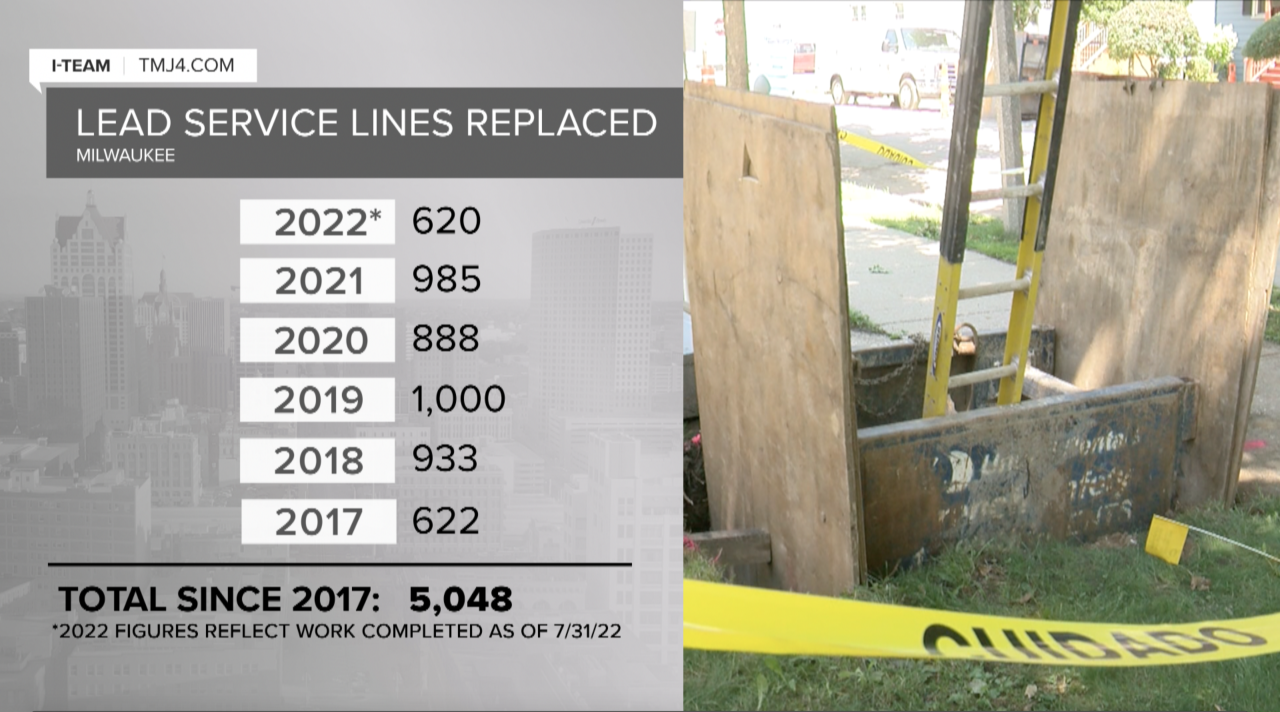MILWAUKEE — Even with millions of dollars coming to Wisconsin to replace lead service lines, it won’t be enough to complete the job. At least, not for another six decades. Milwaukee is facing challenges in replacing more than 60,000 lead service lines that could be carrying contaminants into your home.
An area near 12th and Cleveland in Milwaukee is just one block on one street in the city where lead service lines have been replaced. The city recently hit a milestone of replacing 5,000 lines since 2017.
Lead service lines are filled with potentially lethal contaminants that can leach into the drinking water and lead to serious health hazards, namely for pregnant women and children.
But, knocking out 5,000 lines is a drop in the bucket compared to the work ahead, according to the Superintendent of Milwaukee Water Works Patrick Pauly.
“We have a little over 65,000 [lead service lines] according to our records,” Pauly told the I-Team.
Superintendent Pauly is tasked with figuring out how to replace all of these lead service lines.
Since 2017, no more than 1,000 lead service lines have been replaced in a single year.

The I-Team asked Pauly if the pace Milwaukee Water Works is replacing service lines can be improved. “Is 1,000 lines a year good enough?”
“65 more years is too long. We are in agreement with that,” Pauly responded.
Money coming to Wisconsin from President Joe Biden’s Bipartisan Infrastructure Law will help put a dent in the daunting number of lines to be replaced.
“So the first year the state of Wisconsin has been allocated a little over $48 million. Forty-nine percent of that is principal forgiveness. So a little over $24 million and so that is to be distributed throughout the State of Wisconsin,” said Pauly.
It’s unclear yet how much of that money Milwaukee will receive, but money is not just the city’s problem. It falls on property owners too. The average total cost is around $11,000, which is split between the city and the homeowner.

If a property owner volunteers for a replacement, they are responsible for paying 100 percent of the private side, around $5,100, and the utility pays 100 percent of its side. But, if there is a planned project or a pipe breaks on its own, the property owner is responsible for one-third of the cost which is around $1,700.
The I-Team asked Pauly why there is such a difference in price.
“That's another topic that will be under discussion with the Mayor's Office and the [Common] Council: whether or not the program can accommodate an owner-initiated request and understanding that the cost efficiencies come when we can program full blocks of replacements at a time,” Pauly said.
Pauly also cites workforce shortages and supply chain issues as speed bumps to getting the work done. “We are seeing delivery dates six months out, when over the past four decades it's been 30 days.”
Despite these challenges, Pauly says the city is on track to meet its goal of 1,100 lines replaced in 2022. He’s also adamant Milwaukee’s water is safe.
“Source water of Lake Michigan, and we're blessed to have a source water like Lake Michigan is lead free. The water coming out of our treatment plants is lead free,” said Pauly.
To take extra precautions, Pauly suggests everyone let their water run for 2-3 minutes each morning before drinking. This can also be achieved by showering or running a dishwasher.
Richard Diaz is the chairperson of the Coalition on Lead Emergency (COLE).
The group works to educate and raise awareness about lead in Milwaukee. He says while any amount of money toward lead abatement is good, there needs to be more.
“If you look at other cities, they realize that it's not just going to be public sector dollars that replace our lead service lines and that abate homes. We need to get buy-in from philanthropy,” Diaz said.
Since the lead problem in Flint, Mich. grabbed national headlines, a lot of focus has been on high lead levels in water. Diaz said it is far from the only culprit in this crisis.
“That's why we have our name COLE, the Coalition on Lead Emergency. We're not the coalition on paint, not the coalition on water emergency. We're the coalition or lead emergency.”
Milwaukee residents can check to see if their home has a lead service line online by checking the city's lead service line records.
To read more about Milwaukee’s program to replace lead service lines, and what to do if you have a lead service line, head to the city's website.




